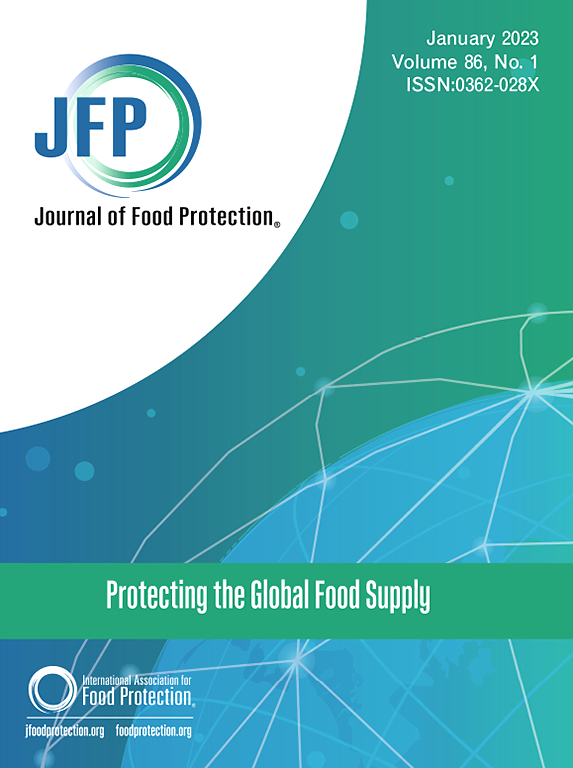Effect of Ripening Temperature on Microbial Safety and Biogenic Amine Levels in Rennet Cheeses Produced from Raw Cow Milk
IF 2.1
4区 农林科学
Q3 BIOTECHNOLOGY & APPLIED MICROBIOLOGY
引用次数: 0
Abstract
Europe is the largest producer and consumer of cheese, with growing interest in raw milk cheeses due to their natural qualities and unique flavor. However, the absence of pasteurization increases the risk of pathogens and biogenic amines (BAs), which can cause foodborne illnesses. This study examined the effect of two ripening temperatures (5 °C and 12 °C) on microbial quality and BAs in rennet cheeses made from unpasteurized cow’s milk over 63 days. Microbial counts and BAs were analyzed at nine ripening stages (0, 7, 14, 21, 28, 35, 42, 50, and 63 days). BAs, including histamine, tyramine, tryptamine, and putrescine, were quantified using high-performance liquid chromatography (HPLC) with a UV/VIS DAD detector. Microbiological tests followed ISO standards, assessing total microorganisms, lactic acid bacteria, molds, yeasts, E. coli, Enterobacteriaceae, coagulase-positive staphylococci, Salmonella spp., L. monocytogenes, and Campylobacter spp. Data were analyzed using ANOVA with Bonferroni correction (P < 0.05). Although raw milk samples did not meet hygiene standards, neither the milk nor cheese contained Salmonella spp., L. monocytogenes, or Campylobacter spp. Ripening temperature significantly affected BA levels, with cheeses ripened at 12 °C showing higher total BAs (464.08 mg/kg) than those at 5 °C (296.63 mg/kg), with tyramine being most prevalent. A positive correlation was found between raw milk use and increased tyramine levels, further elevated by higher ripening temperatures. The presence of hygiene indicator microorganisms (molds, yeasts, staphylococci, E. coli, Enterobacteriaceae) and elevated BA levels highlight the need for strict control measures to ensure cheese safety.
熟化温度对生牛乳凝乳奶酪微生物安全性及生物胺含量的影响
欧洲是最大的奶酪生产国和消费国,由于其天然品质和独特风味,人们对生牛奶奶酪的兴趣日益浓厚。然而,缺乏巴氏消毒会增加病原体和生物胺(BAs)的风险,这可能导致食源性疾病。本研究检测了两种成熟温度(5°C和12°C)在63天内对未经巴氏消毒的牛奶制成的凝乳酶奶酪的微生物质量和BAs的影响。在9个成熟阶段(0、7、14、21、28、35、42、50和63天)分析微生物计数和BAs。采用高效液相色谱(HPLC)和紫外/可见DAD检测器对组胺、酪胺、色胺和腐胺进行定量分析。微生物学检测按照ISO标准,评估总微生物、乳酸菌、霉菌、酵母菌、大肠杆菌、肠杆菌科、凝固酶阳性葡萄球菌、沙门氏菌、单核增生乳杆菌和弯曲杆菌,数据采用Bonferroni校正的方差分析(P < 0.05)。虽然原料奶样品不符合卫生标准,但牛奶和奶酪都不含沙门氏菌、单核细胞增多乳杆菌和弯曲杆菌。成熟温度对BAs含量有显著影响,12°C成熟的奶酪总BAs (464.08 mg/kg)高于5°C成熟的奶酪(296.63 mg/kg),其中酪胺含量最高。在原料奶的使用和酪胺含量的增加之间发现了正相关关系,成熟温度越高酪胺含量越高。卫生指标微生物(霉菌、酵母菌、葡萄球菌、大肠杆菌、肠杆菌科)的存在和BAs水平的升高突出表明需要采取严格的控制措施以确保奶酪的安全。
本文章由计算机程序翻译,如有差异,请以英文原文为准。
求助全文
约1分钟内获得全文
求助全文
来源期刊

Journal of food protection
工程技术-生物工程与应用微生物
CiteScore
4.20
自引率
5.00%
发文量
296
审稿时长
2.5 months
期刊介绍:
The Journal of Food Protection® (JFP) is an international, monthly scientific journal in the English language published by the International Association for Food Protection (IAFP). JFP publishes research and review articles on all aspects of food protection and safety. Major emphases of JFP are placed on studies dealing with:
Tracking, detecting (including traditional, molecular, and real-time), inactivating, and controlling food-related hazards, including microorganisms (including antibiotic resistance), microbial (mycotoxins, seafood toxins) and non-microbial toxins (heavy metals, pesticides, veterinary drug residues, migrants from food packaging, and processing contaminants), allergens and pests (insects, rodents) in human food, pet food and animal feed throughout the food chain;
Microbiological food quality and traditional/novel methods to assay microbiological food quality;
Prevention of food-related hazards and food spoilage through food preservatives and thermal/non-thermal processes, including process validation;
Food fermentations and food-related probiotics;
Safe food handling practices during pre-harvest, harvest, post-harvest, distribution and consumption, including food safety education for retailers, foodservice, and consumers;
Risk assessments for food-related hazards;
Economic impact of food-related hazards, foodborne illness, food loss, food spoilage, and adulterated foods;
Food fraud, food authentication, food defense, and foodborne disease outbreak investigations.
 求助内容:
求助内容: 应助结果提醒方式:
应助结果提醒方式:


